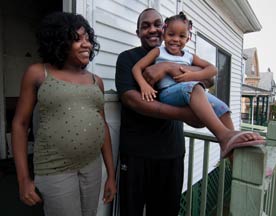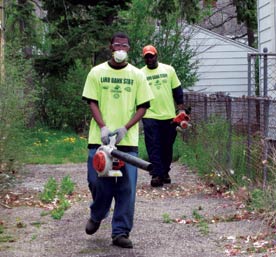As important as dealing with delinquent mortgages preforeclosure is, neighborhood stabilization also requires dealing with the fact that the horse is already out of the barn. Neighborhoods are flooded with vacant properties, many of which are foreclosed, and some of which are REO (real estate owned, i.e. lender/investor owned).
From the beginning, of course, nonprofits and mission-oriented for-profits have been attempting to get control of these properties, rehab them, and get them reoccupied in order to stabilize the neighborhoods they pock-mark. Three rounds of NSP funding have been distributed through local governments and collaborative efforts with nonprofits to mission-oriented developers. Innovation has abounded despite frustration with restrictive regulations. Community developers have bit the bullet on targeting resources, challenged their own ideas about rehab levels and demolition, and brought their own strengths, combining neighborhood organizing, advocacy, and other quality of life programs to try to increase the ripple effects.
But even the most exciting of these projects fall short of the scale that’s needed. Oliver Chang, a Morgan Stanley analyst based in San Francisco, put out a report last October that predicted that about 7.5 million homes with a current market value of $1 trillion will be liquidated through foreclosures or other distressed sales by 2016, according to Bloomberg News. “It was an eye-opener to hear HUD and some economists say we’ll only touch 1 percent of one year’s worth of foreclosure over the years of the NSP programs,” says Kate Krietor of the city of Phoenix’s NSP programs. “It’s daunting to think of it that way.”
Carolyn Olson, president of Minneapolis’s Greater Metropolitan Housing Corporation, says they bought about 300 foreclosures through the First Look program of the National Community Stabilization Trust, (NCST), clustered in North Minneapolis where the greatest need was. They sold about 50 of them back to the city (which demolished 35) or to nonprofits/responsible for-profits working with NSP money. They demolished 50 and renovated the rest directly into for-sale single family homes, and implemented a contract-for-deed program to deal with the credit issues facing potential buyers. They sold 25 in the first half of 2011, 47 in 2010, 85 in 2009. “It’s kind of a drop in the bucket,” says Olson.
In Chicago, Mercy Portfolio Services, which administers the city’s NSP funds, has focused on using the funds for multifamily apartment buildings on key corners, because the bang for the buck is so much higher than with single-family homes. Los Angeles’s NSP program has also gone after many key multifamily buildings.
On the private side, some smaller REO purchasers have been fixing up properties for rental or lease-purchase, something likely to pick up as the GSEs explore bulk REO sales. So far, however, many more REO investors have either gotten in over their heads with decrepit properties that don’t pencil out or are intentionally speculating from afar, leaving many neighborhoods even worse off, and housing and neighborhood advocates skeptical of the entire idea of private investment in REO, especially in bulk (see “Tackling Bank Walkaways and Vulture Investors,” SF Fall/Winter 2010).
The concept of addressing REO property at scale with private investment is a tricky one. It involves balancing efficiencies of scale with the ability to target investment and, as Eric Belsky of the Joint Center for Housing Studies puts it, “do no harm” despite the tenuous, fragile conditions of both properties and neighborhoods. It also involves questions of capacity — both financial capacity for swift acquisitions and development capacity to affordably turn around properties at a faster clip.
Acquisition/Pricing
Early on, the question of financial capacity to acquire properties quickly before cash buyers snapped them up was one of the biggest challenges facing stabilization advocates, especially in markets that are not the most distressed. “We’ve been competing with investors since day 1 of NSP,” says Krietor from Phoenix. “We don’t get access to inventory where we think we can have the greatest impact.”
Of course NCST’s First Look program was designed to address this problem, giving cities and nonprofits “first look” at properties before they went on the open market. It’s become a valuable tool for many REO buyers, but users need to come with capital in hand to close the deal, and they need to find a combination of prices and funding that make sense.
“Valuation is often the real problem here,” says Craig Nickerson of NCST, arguing that appraisers need to be brought into neighborhood stabilization discussions. “A lot of deals don’t happen because of price.” Doug Guthrie of Los Angeles’s NSP program echoes that theme. “We’ve been surprised at unwillingness of banks to drop their prices.”
“The problem is there’s not enough gap money,” explains Olson. “These properties need too much repair if you have to make them livable to the standards you adhere to.” Making them salable is yet another step, she adds. “We can get capital all day. That’s not a problem for us. Capacity has not been a problem either. Gap money is the issue.”
Development Capacity
Capacity to do the rehab and get units occupied is just as important as acquisition capacity. As the number of properties needing attention skyrocketed, many neighborhood stabilization actors — whether regional intermediaries like New Jersey’s Community Asset Preservation Corporation, or NSP administrators like Mercy or the City of Phoenix — have realized that the existing nonprofit development infrastructure couldn’t keep up with the demand, and have built working relationships with responsible for-profit developers as well, in many cases funneling more properties through the for-profits, which are set up for speed.
Recognizing this, NCST has created a program for what it calls its “strategic developer partners,” which allows vetted for-profit developers who agree to work within the parameters set by the local government to have access to NCST’s First Look program right after nonprofits — a “second look” if you will, giving them priority in access to properties over investors at large. “They can leverage more deal making if they work with us,” explains Nickerson.
Phoenix’s move-in ready program has five development partners, four nonprofit and one for-profit. It has also committed NSP funds to assist buyers of properties renovated by for-profit partners in other regions of the city, supporting their comfort level to rehab these houses by ensuring they have qualified, interested buyers, without subjecting them to the regulations and reporting required if they were using NSP funds directly in their development process.
Exit Strategies
To make an REO strategy work, you need an end game. And for each of the two major exit strategies — resale and rental — there are specific challenges of their own to be overcome. For rental, it’s capacity to manage scattered site rentals, especially one- to four-unit properties. “Chicago doesn’t have a single housing organization that has infrastructure for scattered site rental,” says Mercy’s Bill Goldsmith. “Everyone we know who has tried scattered site has gone out of the business. Even PHAs try to get out,” says Olson. “I wish it wasn’t the case, particularly if everyone is telling people they shouldn’t buy, they should be renters.” But groups are working the problem. (Read more on scattered-site rental.)
On the purchase side, the challenge is credit for potential buyers, many of whom have suffered a foreclosure or short sale, periods of unemployment, or just fall below newly inflexible credit score rules. The Community Loan Fund of the Capital Region, in Albany, N.Y., began a residential lending program in 2010, and many of its loans are to borrowers who are slipping through the cracks in the new lending environment.
In the face of that, some organizations are looking at interim methods like lease-purchase (see Can Lease-Purchase Save Us? SF, Winter 2010). GMHC is using a contract for deed program they call Bridge to Success, where they expect participants to be refinancing into a traditional mortgage within three to four years.
Does Scale = Bulk?
Neighborhood stabilization advocates are eager to be transforming a greater percentage of the foreclosures haunting their target areas. “The banks will not sell in bulk,” says LA’s Guthrie with frustration. “We could do more units. We’re there now. We know how to do this, delivering a product at price point, finding buyers.”
But bulk purchases are not an easy answer to the question of getting to scale. Bulk sales of REO are in fact happening, but much as with notes, the large pools tend to be national, and not allow for cherry picking or targeting. Bulk with no targeting doesn’t translate to stabilization effects, argues Nickerson. If you’re not “disciplined about where to buy . . . that’s a travesty because there is no neighborhood you’re stabilizing. You’re just buying housing.”
Even if you could target the pools, that doesn’t mean you’d end up being able to snap up a significant percent of a distressed neighborhood’s vacant properties. Even in a neighborhood with very high vacancy rates, only a fraction of vacant properties are REO in the first place. Bill Goldsmith, of Mercy Portfolio Services, estimates that in their 17-neighborhood target area less than 20 percent of vacant properties are actually available as REO. That’s not unique to Chicago. And of those that are REO, the number held by any given lender or controlled by any given servicer in a specific targeted area is going to be low; possibly half a dozen. That doesn’t make for a bulk sale.
Regional-level intermediaries like New Jersey’s Community Asset Preservation Corporation are looking at “mini-bulk” — 10 to 50 properties in a smaller geographic area that they can pass through to local developer partners in targeted neighborhoods, cross-subsidizing the work with better properties located elsewhere. This seems to be a viable strategy if the pools come at the right price. Except for one Fannie Mae program, however, buyers report that not only are there no discounts available on such “mini-bulk,” but sometimes sellers even try to attach a premium to them, arguing that the buyer is saving on transaction costs.






Comments